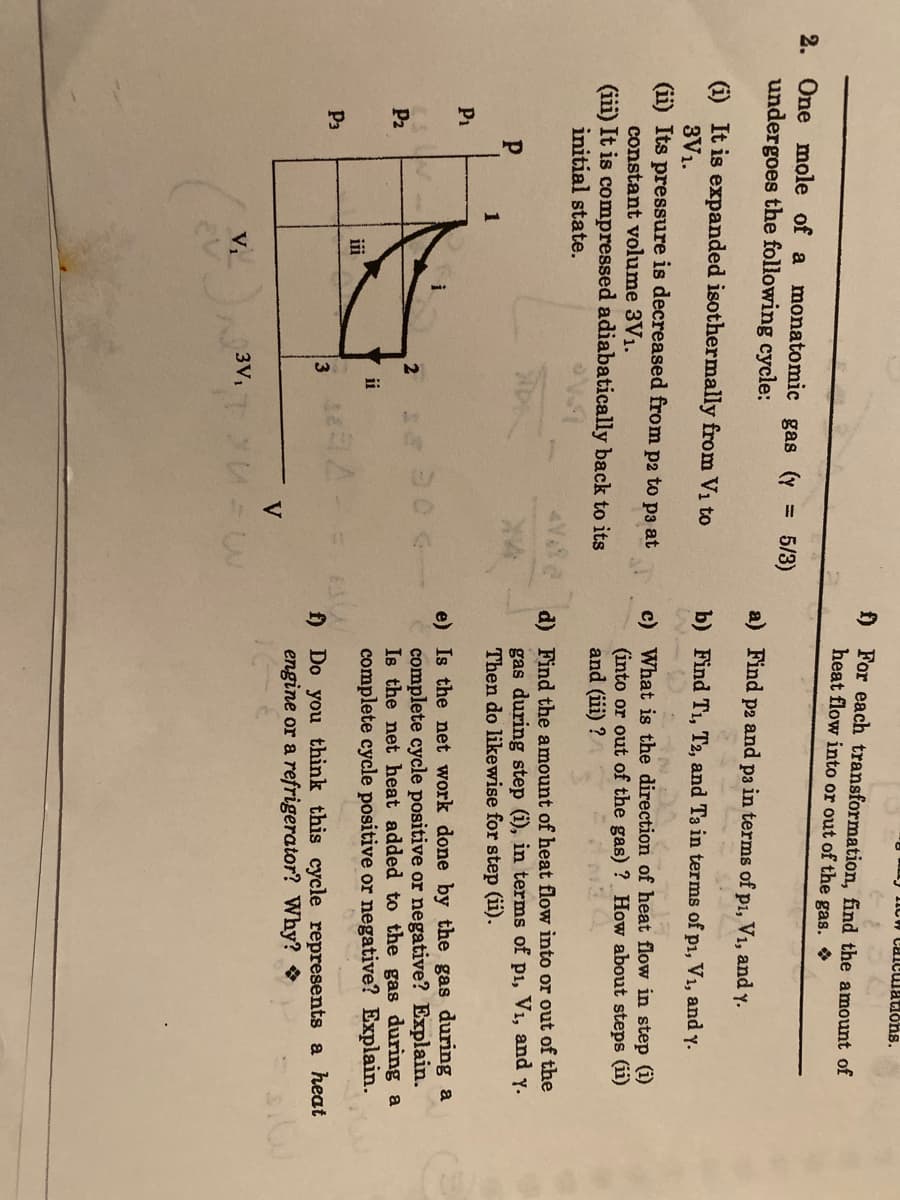ne mole of a monatomic gas ndergoes the following cycle: ) It is expanded isothermally from 3V1. i) Its pressure is decreased from E constant volume 3V1. sii) It is compressed adiabatically b initial state. P1 P2 ii iii P3 3 V1 3V,
ne mole of a monatomic gas ndergoes the following cycle: ) It is expanded isothermally from 3V1. i) Its pressure is decreased from E constant volume 3V1. sii) It is compressed adiabatically b initial state. P1 P2 ii iii P3 3 V1 3V,
Elements Of Electromagnetics
7th Edition
ISBN:9780190698614
Author:Sadiku, Matthew N. O.
Publisher:Sadiku, Matthew N. O.
ChapterMA: Math Assessment
Section: Chapter Questions
Problem 1.1MA
Related questions
Question
100%
A-c please

Transcribed Image Text:ICw caiculations.
f) For each transformation, find the amount of
heat flow into or out of the gas.
2. One mole of a monatomic gas (y
undergoes the following cycle:
5/3)
%3D
a) Find
рг and
p3
in terms of p1, V1, and y.
(i) It is expanded isothermally from V1 to
3V1.
(ii) Its pressure is decreased from p2 to p3 at
constant volume 3V1.
b) Find T1, T2, and T3 in terms of p1, V1, and y.
c) What is the direction
(into or out of the gas) ? How about steps (ii)
and (iii) ?
heat flow in step (i)
(iii) It is compressed adiabatically back to its
initial state.
d) Find the amount of heat flow into or out of the
gas during step (i), in terms of p1, V1, and y.
Then do likewise for step (ii).
P1
e) Is the net work done by the gas during a
complete cycle positive or negative? Explain.
Is the net heat added to the gas during a
complete cycle positive or negative? Explain.
2
P2
ii
iii
P3
f) Do you think this cycle represents a heat
engine or a refrigerator? Why?
3V1
Expert Solution
This question has been solved!
Explore an expertly crafted, step-by-step solution for a thorough understanding of key concepts.
Step 1: Given data
VIEWStep 2: Finding P2 and P3 in term of p1 , V1 and (y)
VIEWStep 3: Finding T1 ,T2 and T3 in term of p1 , V1 and (y)
VIEWStep 4: Direction of heat flow in step (1) , step (2) & step (3)
VIEWStep 5: Calculating the amount of heat flow in step 1 & step 2
VIEWStep 6: Finding the Net work by the gas during complete cycle
VIEWStep 7: Cycle is heat engine or Refrigerator?
VIEWStep by step
Solved in 7 steps

Knowledge Booster
Learn more about
Need a deep-dive on the concept behind this application? Look no further. Learn more about this topic, mechanical-engineering and related others by exploring similar questions and additional content below.Recommended textbooks for you

Elements Of Electromagnetics
Mechanical Engineering
ISBN:
9780190698614
Author:
Sadiku, Matthew N. O.
Publisher:
Oxford University Press

Mechanics of Materials (10th Edition)
Mechanical Engineering
ISBN:
9780134319650
Author:
Russell C. Hibbeler
Publisher:
PEARSON

Thermodynamics: An Engineering Approach
Mechanical Engineering
ISBN:
9781259822674
Author:
Yunus A. Cengel Dr., Michael A. Boles
Publisher:
McGraw-Hill Education

Elements Of Electromagnetics
Mechanical Engineering
ISBN:
9780190698614
Author:
Sadiku, Matthew N. O.
Publisher:
Oxford University Press

Mechanics of Materials (10th Edition)
Mechanical Engineering
ISBN:
9780134319650
Author:
Russell C. Hibbeler
Publisher:
PEARSON

Thermodynamics: An Engineering Approach
Mechanical Engineering
ISBN:
9781259822674
Author:
Yunus A. Cengel Dr., Michael A. Boles
Publisher:
McGraw-Hill Education

Control Systems Engineering
Mechanical Engineering
ISBN:
9781118170519
Author:
Norman S. Nise
Publisher:
WILEY

Mechanics of Materials (MindTap Course List)
Mechanical Engineering
ISBN:
9781337093347
Author:
Barry J. Goodno, James M. Gere
Publisher:
Cengage Learning

Engineering Mechanics: Statics
Mechanical Engineering
ISBN:
9781118807330
Author:
James L. Meriam, L. G. Kraige, J. N. Bolton
Publisher:
WILEY